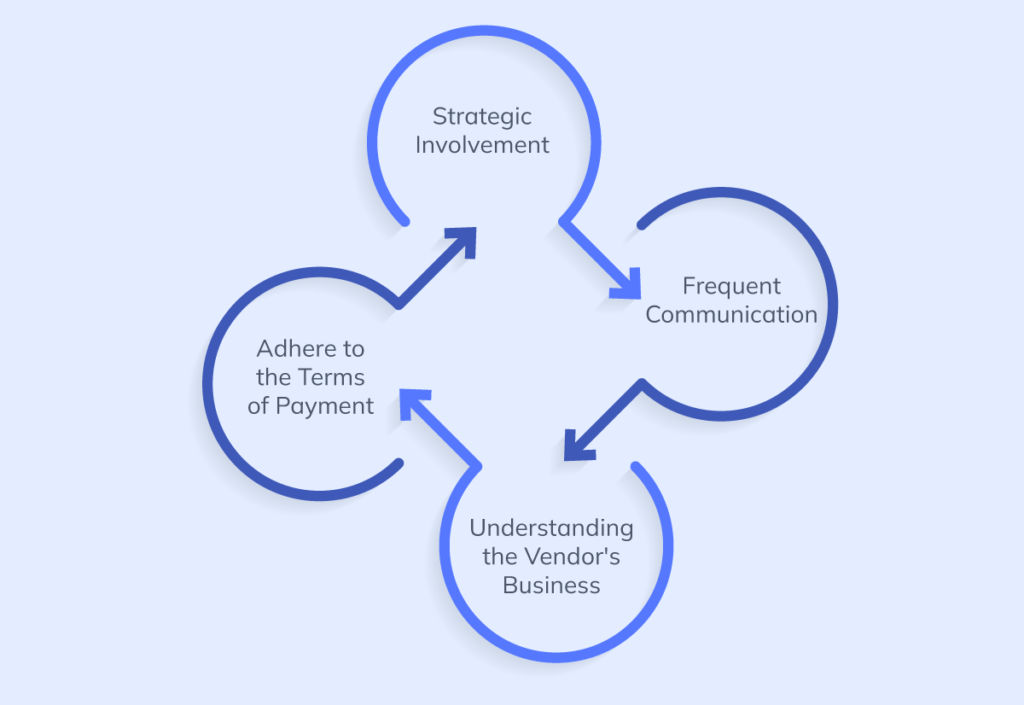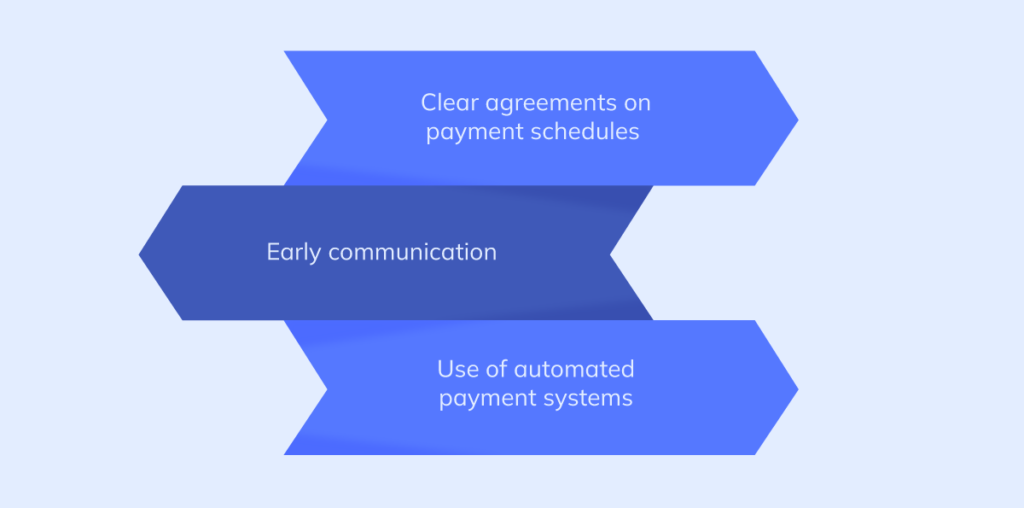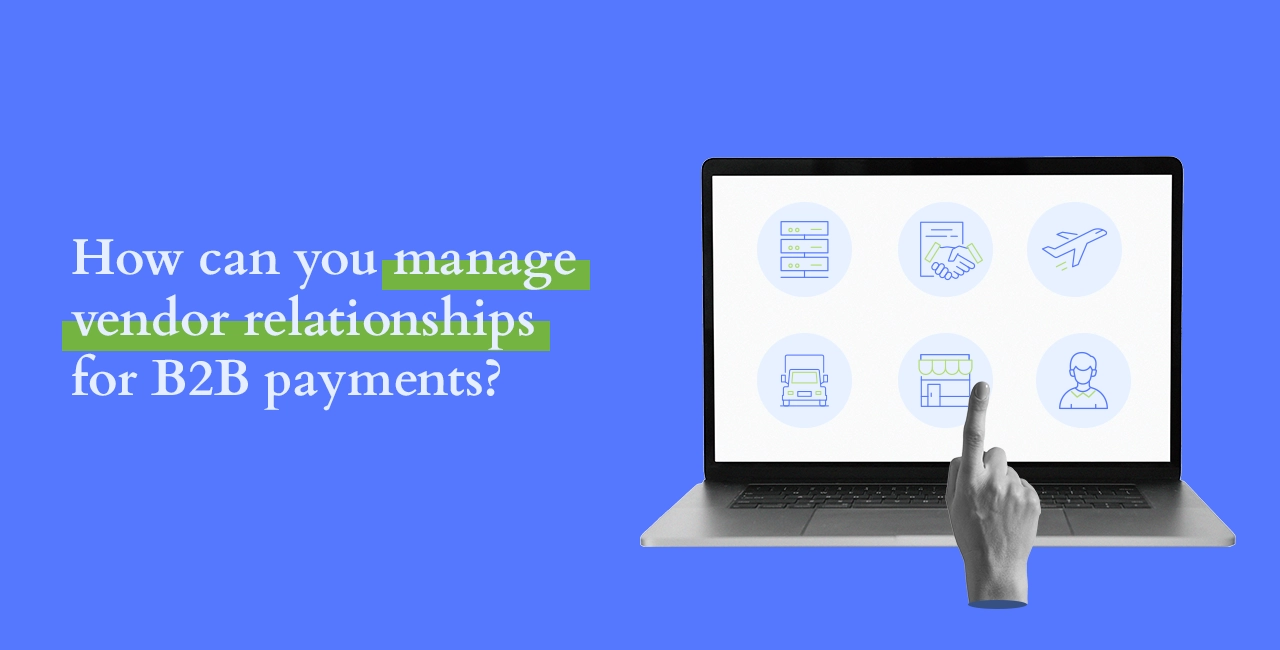Vendor relationships are a fundamental aspect of the business model. They play a crucial role in the interactions between suppliers and buyers.
The ability to effectively manage vendor relationships is essential for ensuring the smooth operation of these partnerships. Contracts form the basis of these relationships, outlining the terms of engagement and guiding the management strategies to ensure the smooth operation and success of partnerships.
Successful vendor relationships go beyond mere transactions; they evolve into strategic alliances that significantly impact a business’s success.
Establishing fair and timely payments fosters a sense of interdependence and trust between companies and their suppliers.
This interdependence is vital for a healthy business ecosystem, ensuring both parties are invested in each other’s success.
Understanding Vendor Relationship Management (VRM)
Vendor Relationship Management (VRM) is a strategic approach within the B2B context that focuses on cultivating collaborative and mutually beneficial partnerships with suppliers beyond the procurement process to encompass the entire vendor management process, including selection, the onboarding process, performance management, and the development of long-term relationships.

The ideal outcomes of VRM include enhanced procurement efficiency, risk mitigation, and the realization of additional value from vendor relationships.
Implementing a VRM solution is the most effective way to enhance the vendor relationship management process. To improve vendor relationships, it’s essential to be transparent with your vendors, conduct annual evaluations, and understand their business and operations.
Vendor Relationship Management emphasizes the shift from prioritizing cost savings to recognizing the overall value that vendors bring to the table, including innovation, quality standards, and alignment with goals.
The concept of VRM dates back to its introduction by the Harvard Business Review in 1983 when it was recognized as a means to improve business operations by effectively managing relationships with strategic vendors.
Over time, vendor relationship management has grown to encompass various strategies and practices designed to optimize several key benefits of vendor partnerships.
Effective VRM requires procurement teams to communicate openly with vendors, establish trust, and work towards win-win partnerships.
Strategic Alliances: Nurturing Vendor Relationships for Success

Building and managing vendor relationships are fundamental processes for achieving operational excellence. These partnerships require meticulous planning, comprehensive evaluations, and continuous oversight.
This initial phase involves identifying potential vendors through research, referrals, or industry associations. It is followed by a rigorous evaluation based on predefined criteria and Know-Your-Vendor verifications.
The aim is to ensure that the chosen vendors meet the business’s needs, share its long-term objectives, and adhere to relevant regulations and standards.
Key Criteria for Selecting the Right Vendors

Selecting the right vendors is a nuanced process that considers various factors, including spending thresholds for different procurement categories and the critical nature of the sourced services or products.
Selecting the right vendor requires a nuanced approach. Consider various factors, such as spending limits for different purchase categories and the importance of the sourced goods or services.
Establishing trust and fostering established relationships with vendors is paramount, as these elements form the bedrock of a mutually beneficial partnership. Vendors that align with the company’s strategic vision and demonstrate a commitment to collaboration are more likely to contribute to the business’s success.
Unveiling the Essentials of Know-Your-Vendor Verification
Know Your Vendor (KYV) verification is a due diligence process that businesses use to verify the identity and assess the reliability of their vendors.

KYV is similar to the Know Your Customer (KYC) process used in the financial industry but is tailored to the B2B environment, focusing on suppliers rather than customers.
The KYV process involves collecting and evaluating information to confirm the legitimacy of vendors, understand their business activities, and assess the risks they may pose. This includes verifying the vendor’s identity, checking their financial stability, ensuring they are licensed to perform the required work, and evaluating their compliance with regulatory standards.
By conducting thorough due diligence, companies can protect themselves from potential involvement in fraud, corruption, money laundering, terrorist financing, and other illicit activities that could harm their reputation and financial standing.

Bancoli’s Scale and Entreprise membership plans offer KYV verifications with US-level banking processes to establish more secure and reliable partnerships. These partnerships are essential for maintaining a resilient supply chain and protecting against disruptions, revenue loss, and reputational damage.
Safeguarding Success: Strategic Risk Management in Vendor Relationships
Risk management is a critical component of vendor relationship management. It encompasses identifying, assessing, and mitigating risks associated with vendor interactions. These risks can range from supply chain disruptions to compliance issues, potentially impacting business operations and reputation.
Early risk assessment and contingency plans are essential to mitigate these risks. Diversifying your vendor base and conducting regular risk assessments can help minimize dependence on any single vendor and prepare your business for unforeseen challenges.
Managing and Strengthening Vendor Accounts

A vendor account represents the formalized financial and operational relationship between a business and its vendors. It encompasses all transactions, communications, and agreements made with a vendor.
Best practices in managing vendor accounts include regular reviews of account performance, adherence to contractual obligations, and timely payments. These practices ensure the relationship remains positive and productive, contributing to smoother operations and potentially unlocking better terms and innovations from vendors.
Strong Communication Channels for Effective Vendor Relationship Management
Effective communication is the cornerstone of successful vendor relationship management (VRM). It involves setting clear expectations, building rapport, and ensuring that both parties are on the same page.
Clear and consistent communication sets the foundation for a healthy vendor relationship. It helps align expectations, resolve conflicts, and build trust.
Utilizing various communication channels, such as emails, meetings, and collaborative platforms, can help consolidate information and facilitate smoother interactions.
For instance, regular status updates and feedback sessions can help identify and address issues promptly, fostering a culture of open dialogue and mutual respect.
Enhancing Operations: The Intersection of Communication and Technology
Clear communication and efficient data sharing are vital components in managing vendor accounts. They facilitate the exchange of information regarding order specifications, delivery schedules, and performance feedback. Technology plays a pivotal role in streamlining these processes.
Vendor management systems (VMS) and other software solutions can automate many aspects of vendor account management, from managing vendors to tracking orders and invoices to evaluating vendor performance. By leveraging technology, businesses can enhance transparency, reduce errors, and foster a more collaborative relationship with their vendors.
Leveraging Innovation for Growth in Vendor Relations
Strong vendor relationships can be a significant source of innovation and business growth. Vendors often possess unique insights and capabilities that, when leveraged through a collaborative relationship, can lead to developing new products, services, or processes.
Example
A software company seeking to improve its data security might collaborate with cybersecurity vendors. This vendor’s knowledge of emerging threats and the software company’s understanding of its product and customer needs could lead to co-creating a new security feature, benefiting both parties.
Creating a Win-Win Vendor Relationship
A key strategy in managing vendor relationships is to create win-win situations where both parties benefit. This can be achieved by understanding the vendor’s business and involving them in strategic decisions that may affect their operations. Using Bancoli, you can settle invoices and benefit from cash flow management tools.
Addressing Common Challenges
Managing vendor relationships can present challenges, from misaligned expectations to communication breakdowns. Strategies for overcoming these obstacles include establishing clear contracts, maintaining open lines of communication, and setting up regular review meetings to address any issues proactively.
Quick Tips for Improving Vendor Relations

- Frequent Communication: Regular check-ins can help anticipate and resolve potential issues before they escalate.
- Strategic Involvement: Including vendors in strategic planning sessions can provide valuable insights and foster a sense of partnership.
- Understanding the Vendor’s Business: Learning about your vendor’s operations and challenges can help you focus more on innovation.
- Adhere to the Terms of Payment: Vendors and suppliers must be paid on time and consistently. Respecting this with frequent communication favors both ways in any relationship.
Ensuring Timely Vendor Payments: Key to Strong Business Relationships

Timely payments are crucial in maintaining a positive and productive relationship with vendors. They respect the vendor’s services and contribute to their financial stability.
Best practices for managing payment terms include clear agreements on payment schedules, early communication regarding potential delays, and the use of automated payment systems to reduce human error.
Vendor Relations Management Tools and Technology
Technology plays a pivotal role in enhancing the efficiency and effectiveness of vendor relationship management. Communication tools, data integration capabilities, and workflow automation can streamline the VRM process, making managing multiple vendors easier and maintaining a comprehensive overview of vendor performance.
For example, a VRM solution that provides real-time data and analytics can improve forecasting, budgeting, and performance management.
Benefits of Implementing a VRM Solution
A VRM solution can offer numerous benefits, including improved operational efficiency, vendor performance, and risk management.
It allows businesses to maintain a centralized database of vendor information, automate routine tasks, and generate actionable insights through analytics.
Building Long-Term Vendor Partnerships

Long-term relationships with vendors are invaluable for businesses seeking stability, reliability, and consistent quality in their supply chain. These partnerships go beyond mere transactional interactions, fostering a deeper understanding and alignment of business goals, which can lead to preferential treatment and collaborative problem-solving.
Vendor Performance and Evaluation
Evaluating vendor performance is crucial for maintaining high standards and ensuring vendor contributions align with your business objectives. Setting Key Performance Indicators (KPIs) specific to the services or products provided by the vendor allows for objective assessment and feedback.
For instance, a logistics vendor’s KPI might include delivery times, while a manufacturing vendor’s might focus on product defect rates.
Using scorecards or vendor ratings facilitates a structured evaluation process, enabling businesses to track performance over time and identify areas for improvement. This systematic approach ensures transparency and accountability, fostering a culture of continuous improvement.
Collaborative Approaches to Vendor Relations
A collaborative approach to vendor relationship management fosters a partnership where both parties work together towards common goals.
This can lead to innovative solutions, improved efficiency, and shared success. For instance, a business might collaborate with a vendor to develop a new product, leveraging the vendor’s expertise and resources to bring something unique to the market.
Bancoli ensures that your business partners are US-level banking verified compliant so that transactions can be conducted with partners to protect their growing businesses from fraudulent activities and compliance risks, facilitating smoother operations and partnerships.

Frequently Asked Questions
1. How can we shift from a transactional to a long-term relationship with vendors?
To move beyond one-off transactions, focus on building trust and communication with your vendors. This can involve jointly setting goals, sharing information openly, and working together to solve problems.
2. What metrics should be used to evaluate vendor performance?
Vendor performance can be assessed through a combination of metrics tracking quality (defect rates, adherence to specifications), reliability (on-time delivery, responsiveness), and cost-effectiveness (pricing, total cost of ownership).
3. How can we assess risks in vendor relationships?
Conduct regular risk assessments focusing on vendor reliability, geopolitical issues affecting supply chains, and compliance with industry regulations. Bancoli’s KYV verification offers relevant information for your vendor risk assessment.
4. What does a collaborative vendor relationship look like?
A collaborative vendor relationship involves open communication, shared goals, and joint initiatives for mutual benefit. Both parties are committed to each other’s success and work closely to overcome challenges and seize opportunities.




